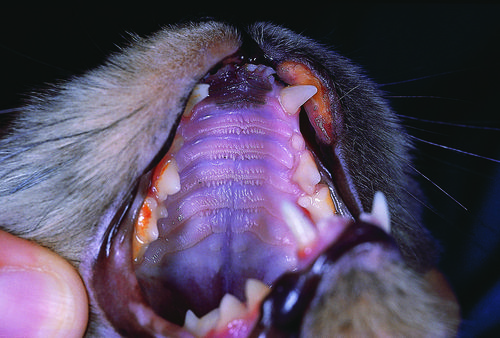Difference between revisions of "Veterinary Dentistry Q&A 05"
Ggaitskell (talk | contribs) |
|||
| (One intermediate revision by the same user not shown) | |||
| Line 1: | Line 1: | ||
| − | |||
| − | |||
| − | |||
[[File:Vet Dentistry 05.jpg|centre|500px]] | [[File:Vet Dentistry 05.jpg|centre|500px]] | ||
| Line 18: | Line 15: | ||
Histologic evaluation of these oral lesions is necessary for definitive diagnosis and to differentiate them from neoplasms, mycotic infections, and foreign body reactions. | Histologic evaluation of these oral lesions is necessary for definitive diagnosis and to differentiate them from neoplasms, mycotic infections, and foreign body reactions. | ||
| − | |l1= | + | |l1= |
|q2=In which breed of dog is this lesion most common, and where do they usually occur in the oral cavity? | |q2=In which breed of dog is this lesion most common, and where do they usually occur in the oral cavity? | ||
|a2= | |a2= | ||
| Line 25: | Line 22: | ||
They also occur on the soft palate. | They also occur on the soft palate. | ||
| − | |l2= | + | |l2= |
|q3=What are the recommended treatment options? | |q3=What are the recommended treatment options? | ||
|a3= | |a3= | ||
| Line 37: | Line 34: | ||
Eosinophilic granulomas may regress spontaneously. | Eosinophilic granulomas may regress spontaneously. | ||
| − | |l3= | + | |l3= |
</FlashCard> | </FlashCard> | ||
Revision as of 20:19, 29 September 2011
The eosinophilic granuloma complex in cats refers to a group of lesions affecting the skin and oral cavity. Oral eosinophilic granulomas also occur in dogs.
| Question | Answer | Article | |
| Which lesions affect cats, and where are they typically located? | Oral lesions in cats are usually eosinophilic ulcers or linear granulomas. Eosinophilic ulcers (e.g. indolent, rodent, and lip ulcers) are non-painful, non-pruritic lesions most commonly found on the upper lip. They are usually well-circumscribed, firm, redbrown to yellow, ulcerated lesions located on each side of the midline. Eosinophilic granulomas (linear granulomas) may occur as single or multiple lesions in a nodular pattern in the oral cavity. Histologic evaluation of these oral lesions is necessary for definitive diagnosis and to differentiate them from neoplasms, mycotic infections, and foreign body reactions. |
[[|Link to Article]] | |
| In which breed of dog is this lesion most common, and where do they usually occur in the oral cavity? | An eosinophilic granuloma may occur in any breed but occurs most commonly in young Siberian Huskies. These lesions are typically identified as proliferative tissue, with or without superficial ulcerations, located primarily on the lateral and ventral surfaces of the tongue. They also occur on the soft palate. |
[[|Link to Article]] | |
| What are the recommended treatment options? | Allergies (e.g. flea, mosquito, biting fly, food, atopy), parasites (e.g. fleas), infectious diseases (e.g. bacterial, dermatophytes, viral), and miscellaneous (genetic, immunemediated, idiopathic) problems have been suggested as underlying causes or predisposing factors for the eosinophilic granuloma complex. When an underlying etiology is identified or suspected, treatment should be directed at eliminating or controlling it. Lesions generally respond to glucocorticoid administration. Cats are usually administered injectable methylprednisolone (2 mg/kg, minimum 20 mg) subcutaneously every two weeks for a total of 2–3 treatments. Dogs are administered prednisone orally at a dosage of 0.5–1.0 mg/kg every 12 hours for seven days then a tapering dose over the following 2–3 weeks. Progestin compounds are not recommended; they are not licensed for use in cats and may be associated with severe side-effects. Refractory eosinophilic ulcers have been successfully treated with carbon dioxide laser treatment in two cases. Eosinophilic granulomas may regress spontaneously. |
[[|Link to Article]] | |
